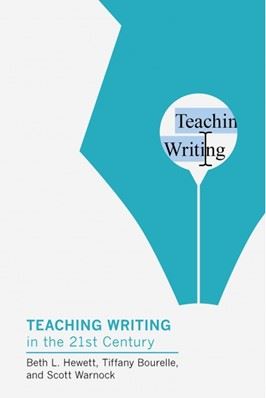Publication Details
| OLOR Series: | OLOR Reviews |
| Author(s): | Beatrice Mendez Newman |
| Original Publication Date: | 2 September 2022 |
| Permalink: |
<gsole.org/olor/reviews/2022.09.02> |
Resource Overview
Media, Figures, Tables |
Resource Contents
Review of Teaching Writing in the Twenty-First Century
Teaching Writing in the Twenty-First Century by Beth L. Hewett, Tiffany Bourelle, and Scott Warnock is at once a refresher on rhet/comp scholarship and a primer on teaching writing in all contexts. It is not a book about how to teach writing online. Instead, the authors assert from the opening pages that the pervasiveness of digitality has made digital instruction in writing “a natural part of [the] twenty-first century teaching environment not a specialty area . . . to address or ignore” (p. 4). This is a book that should be read by long-time, experienced teachers of writing as well as novices, and particularly by graduate students preparing to enter the world of writing studies pedagogy.
Divided into two sections—Part 1. Approaching Composition in the Digital Era and Part 2. Teaching Composition in the Digital Era—the book offers a discussion of what online writing instructors should know about rhetoric, composition, and literacy, and then an explanation of how these foundations support the evolving variety of online teaching spaces. The 12 chapters address key strands of composition instruction, with titles such as “Digitalizing Text, Purpose, and Genre,” “Technologizing Composition Instruction,” and “Teaching Composition in Online Settings.”
A clever feature of the book is Professor Jackson, a fictional instructor whose musings about potential and real issues in teaching launch the discussions in the chapters. Professor Jackson is a sort of Every Instructor, a figure who embodies the nostalgic memories of great things in traditional classrooms while recognizing the need to evolve pedagogically and personally as composition instruction becomes increasingly digitalized. Jackson’s concerns reflect teaching strategies, student engagement, infusion of technology, the need to stay up with new work in rhet/comp, and the emerging needs of students who are no longer primarily “traditional.”
Experienced and novice instructors will appreciate the remixed definitions of core terms to suggest explanations of new terms that have emerged as OWI and OLI have expanded. Those definitions and forthright explanations, which occur abundantly throughout the chapters, are one of the book’s greatest assets. In the Introduction, the authors provide an update for the “definition” of composition: “we define composition in the digital era as a rhetorical communication process in which both thought and expression are engaged and in which various alphabetic, spoken, and digital modes are used to invent, create, arrange, and deliver a product to readers or viewers in digitally enabled media and in print” (p. 4). This quite comprehensive definition encompasses the changes they address in the book, the bottom line being that teaching writing has moved undeniably, with no going back, into digital environments. Recurring through the chapters of this book is the reminder that traditional “alphabetic” production of text, packaged as assigned essays in composition classes, is no longer the only means of submission. Texts now exist in a myriad of multimodal frameworks that support all sorts of compositional creativity; throughout the book, there are segments of advice, how-to’s, and suggestions for moving on the continuum from alphabetic text to multimodal productivity.
It is hard to pull out a specific chapter to highlight because all the chapters add so much to our understanding of the new landscapes for teaching, but “Technologizing Composition Instruction” is possibly the best current explanation of the different instructional frameworks in which we teach today. Notably, the authors remind us that online learning supports equitable access to education and the resulting economic outcomes for “geographically distributed students” whose on-campus access is limited by family, job, disabilities, or location (p. 145). Variations of onsite and online teaching are adeptly defined and explained with sufficient discussion to allow us to figure out exactly how and what we are doing in our own co-located or online classrooms.
This book is practical and helpful. It includes discussions of literacy, multilingualism, assessment, genre, reading, Learning Management Systems, multimodalism, diversity—just about everything that informs our teaching of writing. For instructors who are newer, possibly just starting, Hewett, Bourelle, and Warnock provide sage guidance in negotiating the constantly shifting environment of teaching composition. The abundant references to established and new voices in rhet/comp theory and practice show an amazing breadth and depth in sourcing. Graduate students should look at the Works Cited as a reading list that will bolster their authority as students in rhet/comp and literacy.
A few lines from the closing powerfully express the mindset of this book: “we have reimagined the critical literacies of reading, alphabetic writing, and multimodal composition as the new digital-era composition, urging instructors to be prepared for change while encouraging them that such change will come through them with exciting advancements in how writing and literacy are taught—and studented” (p. 396).
Finally, it is so good to know that the authors are pillars of GSOLE work. As a GSOLE member, I find the abundant references to GSOLE tenets and contributions invigorating and affirmational. GSOLE is presented as a leader in reconceptualizations of literacy in the context of online learning. Every GSOLE member should read this book. It is a book that affirms, continues, expands, and supports the work we do in our diverse, variable classrooms.
 Teaching Writing in the Twenty-First Century
Teaching Writing in the Twenty-First Century
By Tiffany Bourelle, Beth L. Hewett, and Scott Warnock. Modern Language Association, 2022. [Paperback, $36.00; ebook, $30.99-$35.99].
About the Reviewer
Beatrice Mendez Newman, Professor in Writing and Language Studies at the University of Texas Rio Grande Valley, has taught online since 2014. She believes effective online writing instruction must be founded on robust understanding of traditions in rhetoric, composition, and literacy theory and pedagogy.


